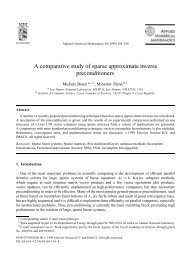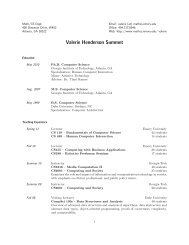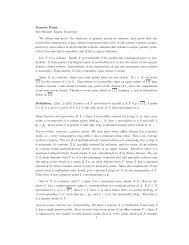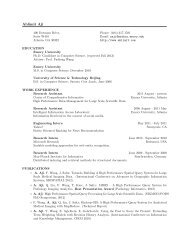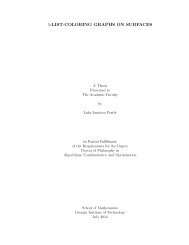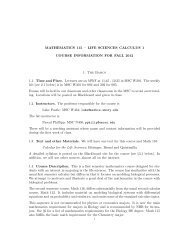Chapter 3 Solution of Linear Systems - Math/CS
Chapter 3 Solution of Linear Systems - Math/CS
Chapter 3 Solution of Linear Systems - Math/CS
You also want an ePaper? Increase the reach of your titles
YUMPU automatically turns print PDFs into web optimized ePapers that Google loves.
52 CHAPTER 3. SOLUTION OF LINEAR SYSTEMS<br />
Row-Oriented Column-Oriented<br />
for i = 3 downto 1 do for j = 3 downto 1 do<br />
for j = i + 1 to 3 xj := bj/aj,j<br />
bi := bi − ai,jxj<br />
for i = 1 to j − 1<br />
next j bi := bi − ai,jxj<br />
xi := bi/ai,i<br />
next i<br />
next i next j<br />
Figure 3.6: Pseudocode Row- and Column-Oriented Backward Substitution<br />
Observe that the right hand sides <strong>of</strong> these equations can again be divided naturally into rows and<br />
columns. Row–oriented backward substitution evaluates the right hand side one row at a time,<br />
while column–oriented backward substitution evaluates the right hand side one column at a time.<br />
Pseudocodes implementing row– and column–oriented backward substitution for systems <strong>of</strong> size<br />
n = 3 are presented in Fig. 3.6.<br />
Problem 3.1.19. Why is a diagonal linear system also an upper triangular linear system?<br />
Problem 3.1.20. Modify the row– and column–oriented pseudocodes in Fig. 3.6 for backward substitution<br />
so they apply to upper triangular linear systems <strong>of</strong> order n for any n.<br />
Problem 3.1.21. Consider a general upper triangular linear system <strong>of</strong> order n. What are the<br />
conditions on the entries <strong>of</strong> the coefficient matrix so that its solution can be determined by each <strong>of</strong><br />
the backward substitution pseudocodes?<br />
Problem 3.1.22. Illustrate the operation <strong>of</strong> column–oriented backward substitution when used to<br />
solve the upper triangular linear system in Fig. 3.1(c). Hint: Show the value <strong>of</strong> b each time it has<br />
been modified by the for-loop and the value <strong>of</strong> each entry <strong>of</strong> x as it is computed.<br />
Problem 3.1.23. Use the row–oriented version <strong>of</strong> backward substitution to solve the following linear<br />
system <strong>of</strong> order 4.<br />
2x1 + 2x2 + 3x3 + 4x4 = 20<br />
0x1 + 5x2 + 6x3 + 7x4 = 34<br />
0x1 + 0x2 + 8x3 + 9x4 = 25<br />
0x1 + 0x2 + 0x3 + 10x4 = 10<br />
Problem 3.1.24. Repeat the previous problem but this time using the column–oriented version <strong>of</strong><br />
backward substitution.<br />
Problem 3.1.25. Modify the row– and column–oriented pseudocodes for backward substitution so<br />
that the solution x is written over b.<br />
Problem 3.1.26. Consider a general upper triangular linear system <strong>of</strong> order n. Show that row–<br />
n(n − 1)<br />
n(n − 1)<br />
oriented backward substitution costs multiplications, subtractions, and n divi-<br />
2<br />
2<br />
sions. Hint: Draw a picture <strong>of</strong> A and place on the entry ai,j the symbol ⊗ every time that entry is<br />
involved in a multiply, the symbol ⊖ every time that entry is involved in a subtract, and the symbol<br />
⊘ every time that entry is involved in a divide. How many symbols are attached to each entry <strong>of</strong> A?<br />
Hint: A more general approach observes that there are (n − i) multiplies and subtracts in the inner<br />
loop and that this loop is executed for each value <strong>of</strong> i = n, (n − 1), · · · , 1. So, the total cost is<br />
multiplies and subtracts.<br />
0 + 1 + · · · + (n − 1) =<br />
n<br />
n−1 n−1 <br />
(i − 1) = i = i<br />
i=1<br />
i=0<br />
i=1



